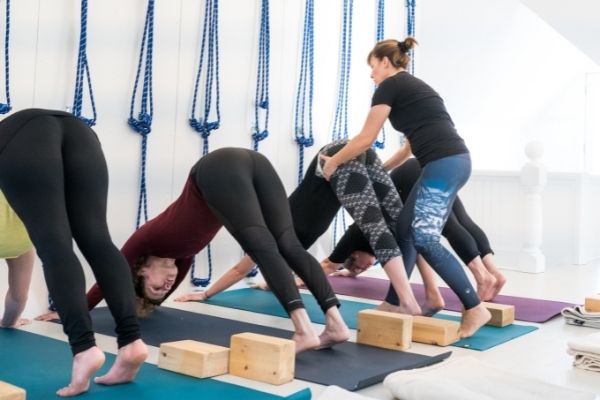Recently, I coordinated a 40 day Spring Sadhana (practice/challenge) to mark the coming of spring. This 40 days of practice commenced on March 20th, in conjunction with the vernal equinox, a time of year where we celebrate renewal and rebirth. Over thirty people decided to join the 40 day Sadhana and, of course, I was delighted to see this level of interest in the offering.
Over the years, I have participated in many Sadhanas of my own. The picture above displays a few of the threads from my many Sadhana’s past. Symbolically, I would tie a thread around my wrist to have a physical reminder of my commitment to practice. Often I would wear them until they fell off. Sometimes I would burn them, sometimes they would just disappear and sometimes I would save them and add them to my incense burner/buddha! Every Sadhana I participated in was most definitely transformational.
Sometimes they went smoothly and relatively easily, at other times, it felt like there were many obstacles in the path of practice and commitment. In either of these two cases, I would come out the other side, learning a lot about myself, myself and my relationship to practice, and the way in which Yoga has had such a deep impact on my life.
Sadhana is an example of tapas. Tapas is a practice that is generally spiritual in nature and aimed at cultivating a sense of self discipline, passion and courage. It is important to note that, like most Sanskrit words, Tapas can have additional meanings depending on how it is being read and by whom. Tapas is the hard work that is necessarily needed to be done to create the habit of practice. Once practice becomes a habit, it becomes a Samskara (behavioral trait), in this case a good one. Tapas can also mean heat and it is related to fire so it is generally related to the burning off negative traits and habits through practice.
My inspiration for this Sadhana comes from Sutra 1.14 of the Yoga Sutras of Patanjali. According to the Yoga Sutras of Patanjali, practice undertaken with devotion, over a long period of time, uninterrupted is the firm foundation required to learn how to train the fluctuations of the mind.
sa tu dīrgha kāla nairantarya satkārā sevito dṛḍhabhūmiḥ
“Long, uninterrupted, alert practice is the firm foundation for restraining the fluctuations. When the effort is continued in accordance with yogic principles consistently and for a long time, with earnestness, attention, application and devotion, the yogic foundation is firmly established.”
BKS Iyengar
I also drew inspiration from the concept of Sankalpa, a yogic life of intention, as our guide for this Sadhana. In addition to this I wanted to inspire students to practice the three pillars of yoga that we follow in the Iyengar tradition, Karma/Kriya Yoga (the yoga of action), Bhakti Yoga (the yoga of devotion, mantra chanting, for example) and Jnana Yoga (the yoga of knowledge, the reading of inspirational yogic texts like the sutras, for example).
It was interesting to see how various students responded to the Sadhana challenge, some signed up right away without question, ready to dive deep into it, others took their time, had many questions, gave it much consideration, and perhaps a little bit too much thought! Both of these sides of the coin are completely understandable and expected, as is our human nature to respond to various things. In both cases, the student was making a commitment to themselves, rather than to myself or the greater community and I think that’s an important distinction when we embark on these challenges, for lack of a better word. As I stated earlier, tapas, the practice that is ongoing and necessary for transformation, is associated with the element of fire, and just like a fire it can be mild, medium or intense. We have to start where we are in a way that is suitable to our current state or disposition, of our lifestyle and our physical capabilities. Mild practice done continuously over 40 days is much more potent than intense practice done sporadically over 40 days. In some cases, where students were overthinking things, I gave them the idea of just practicing one pose for 40 days straight to see what comes of that.
One of the challenges that we face as modern day yogis is that we live in a world that is very goal oriented. Unless we get something for our efforts, our hard work, etc. we feel a lack of a sense of accomplishment. We feel deflated if we don’t achieve our goals. We feel less than, even depressed. If we do achieve our goals we’re happy, satisfied, fortified and perhaps want to take the bar up a notch next time. One of the things that I’ve come to consider over my many years of practice, my many experiences with Sadhana, is that we really shouldn’t be goal oriented in our approach to yoga. Instead, yogic discipline should be a form of dedication and devotion. If we are truly devoted to someone, truly dedicated to them with all our heart, we don’t place layer upon layer of expectation upon them. Well perhaps we do but this would absolutely dilute the devotion and dedication! I even struggled to use the word challenge when I was communicating the ideal of this Sadhana because words are important. I am cognizant of the fact that people like challenges, I like challenges, and have participated in them in the past, but to me, the word feels a little charged in that it’s goal oriented. Or fixated on an end result. Nevertheless, I did sprinkle the word challenge in my communications here and there so people could understand what was involved.
Over the past week I have really appreciated the messages that I’ve received from various students about how the Sadhana has affected or impacted their life. How they’re thinking about it, how they’re incorporating practice into their day to day beingness. I feel so uplifted when I hear students talk about this Sadhana, before or after class specifically as it relates to the conversation lifetime).
“It’s not a question of learning yoga, it is a question of experiencing because yoga has no end. It has only a beginning.”
Geeta Iyengar
I am practicing the 40 day Spring Sadhana right along with my students. When I put this program together, I feel like I had myself in mind. Isn’t it true that we often teach what we personally need or want to work on? Have I set a goal for myself? Yes, but actually, I’m more interested in focusing on the concepts of devotion and dedication to practice this time around. I encourage all of you to embark on your own Sadhana. It doesn’t need to be a program or event hosted by another person. It can be by you, for you, through you fully and completely.
Have you participated in a Sadhana before? If so, I would love to hear your thoughts about them. Please respond to this post and let me know.
“In yoga, three very important things have always to be united in everything: love, knowledge and action.”
BKS Iyengar




